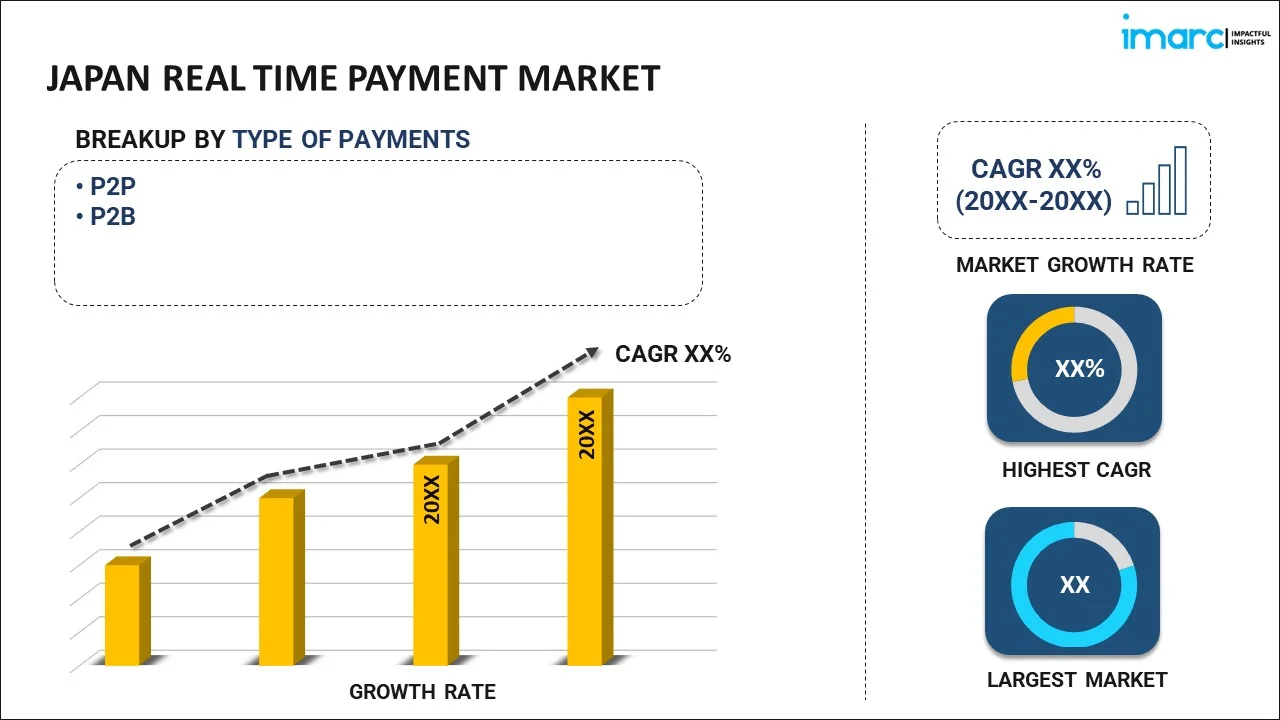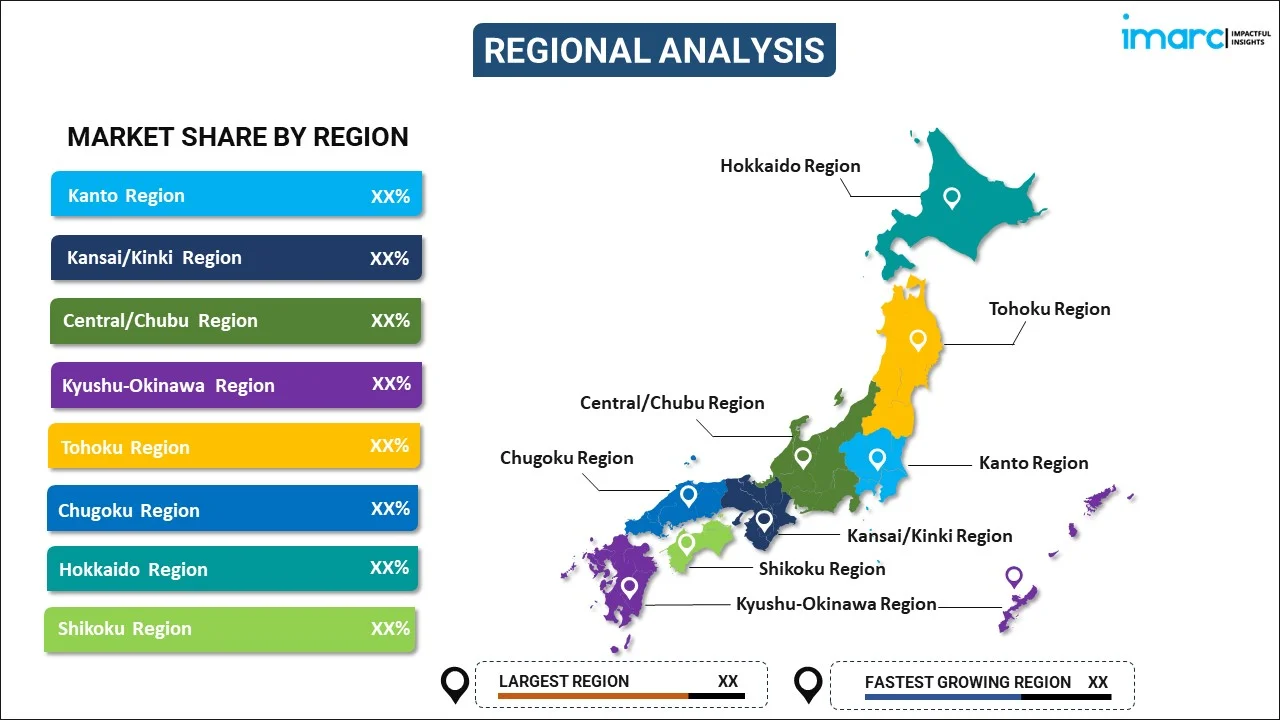
Japan Real Time Payment Market Report by Type of Payment (P2P, P2B), and Region 2025-2033
Market Overview:
Japan real time payment market size reached 2.4 Billion RTP in 2024. Looking forward, IMARC Group expects the market to reach 7.9 Billion RTP by 2033, exhibiting a growth rate (CAGR) of 13.2% during 2025-2033. The growing e-commerce as well as the regional shift towards digitalization and the proliferation of smartphones that have created a demand for digital payment solutions, is primarily driving the market.
|
Report Attribute
|
Key Statistics
|
|---|---|
|
Base Year
|
2024 |
|
Forecast Years
|
2025-2033
|
|
Historical Years
|
2019-2024
|
| Market Size in 2024 | 2.4 Billion RTP |
| Market Forecast in 2033 | 7.9 Billion RTP |
| Market Growth Rate (2025-2033) | 13.2% |
Real time payment refers to a financial transaction processing system that enables instantaneous and immediate fund transfers between individuals, businesses, or institutions. Unlike traditional payment methods that involve delays due to batch processing or clearing times, real-time payments occur in a matter of seconds, providing a swift and efficient means of transferring money. This technology relies on advanced payment infrastructures and networks to facilitate instantaneous settlement, often 24/7, including weekends and holidays. Real time payments have become increasingly popular in recent years, revolutionizing the way people handle financial transactions. They offer benefits such as enhanced convenience, reduced processing costs, improved cash flow management, and greater transparency. Some commonly used real time payment systems include the Faster Payments Service (FPS) in the UK and the Real-Time Gross Settlement (RTGS) system in India. These systems have significantly accelerated the pace of financial transactions, empowering individuals and businesses with the ability to transfer funds in real time, supporting a wide range of financial activities, from bill payments to peer-to-peer transfers.
Japan Real Time Payment Market Trends:
The real time payment market in Japan is experiencing unprecedented growth, primarily driven by several key factors. Firstly, the increasing digitalization of financial services has paved the way for real time payment systems to flourish. As consumers and businesses increasingly demand instant, convenient, and efficient transactions, financial institutions are compelled to adopt real time payment solutions to remain competitive. Furthermore, the regional economy's evolution toward a 24/7 operational model has fueled the need for real time payment capabilities. This shift is particularly evident in the e-commerce sector, where consumers expect instantaneous payment confirmation, thereby boosting the demand for real time payment infrastructure. Additionally, regulatory initiatives and mandates have played a pivotal role in driving the adoption of real time payment systems. Governments and regulatory bodies in Japan have recognized the benefits of real time payments in reducing fraud, enhancing transparency, and fostering financial inclusion. As a result, they have actively promoted and enforced the implementation of real time payment frameworks. Moreover, the proliferation of mobile devices and the increasing popularity of mobile banking apps is expected to drive the real time payment market in Japan.
Japan Real Time Payment Market Segmentation:
IMARC Group provides an analysis of the key trends in each segment of the market, along with forecasts at the country level for 2025-2033. Our report has categorized the market based on type of payment.
Type of Payment Insights:

- P2P
- P2B
The report has provided a detailed breakup and analysis of the market based on the type of payment. This includes P2P and P2B.
Regional Insights:

- Kanto Region
- Kansai/Kinki Region
- Central/ Chubu Region
- Kyushu-Okinawa Region
- Tohoku Region
- Chugoku Region
- Hokkaido Region
- Shikoku Region
The report has also provided a comprehensive analysis of all the major regional markets, which include Kanto Region, Kansai/Kinki Region, Central/ Chubu Region, Kyushu-Okinawa Region, Tohoku Region, Chugoku Region, Hokkaido Region, and Shikoku Region.
Competitive Landscape:
The market research report has also provided a comprehensive analysis of the competitive landscape in the market. Competitive analysis such as market structure, key player positioning, top winning strategies, competitive dashboard, and company evaluation quadrant has been covered in the report. Also, detailed profiles of all major companies have been provided.
Japan Real Time Payment Market Report Coverage:
| Report Features | Details |
|---|---|
| Base Year of the Analysis | 2024 |
| Historical Period | 2019-2024 |
| Forecast Period | 2025-2033 |
| Units | Billion RTP |
| Scope of the Report | Exploration of Historical and Forecast Trends, Industry Catalysts and Challenges, Segment-Wise Historical and Predictive Market Assessment:
|
| Type of Payments Covered | P2P, P2B |
| Regions Covered | Kanto Region, Kansai/Kinki Region, Central/ Chubu Region, Kyushu-Okinawa Region, Tohoku Region, Chugoku Region, Hokkaido Region, Shikoku Region |
| Customization Scope | 10% Free Customization |
| Post-Sale Analyst Support | 10-12 Weeks |
| Delivery Format | PDF and Excel through Email (We can also provide the editable version of the report in PPT/Word format on special request) |
Key Questions Answered in This Report:
- How has the Japan real time payment market performed so far and how will it perform in the coming years?
- What has been the impact of COVID-19 on the Japan real time payment market?
- What is the breakup of the Japan real time payment market on the basis of type of payment?
- What are the various stages in the value chain of the Japan real time payment market?
- What are the key driving factors and challenges in the Japan real time payment?
- What is the structure of the Japan real time payment market and who are the key players?
- What is the degree of competition in the Japan real time payment market?
Key Benefits for Stakeholders:
- IMARC’s industry report offers a comprehensive quantitative analysis of various market segments, historical and current market trends, market forecasts, and dynamics of the Japan real time payment market from 2019-2033.
- The research report provides the latest information on the market drivers, challenges, and opportunities in the Japan real time payment market.
- Porter's five forces analysis assist stakeholders in assessing the impact of new entrants, competitive rivalry, supplier power, buyer power, and the threat of substitution. It helps stakeholders to analyze the level of competition within the Japan real time payment industry and its attractiveness.
- Competitive landscape allows stakeholders to understand their competitive environment and provides an insight into the current positions of key players in the market.
Need more help?
- Speak to our experienced analysts for insights on the current market scenarios.
- Include additional segments and countries to customize the report as per your requirement.
- Gain an unparalleled competitive advantage in your domain by understanding how to utilize the report and positively impacting your operations and revenue.
- For further assistance, please connect with our analysts.
 Request Customization
Request Customization
 Speak to an Analyst
Speak to an Analyst
 Request Brochure
Request Brochure
 Inquire Before Buying
Inquire Before Buying




.webp)




.webp)












